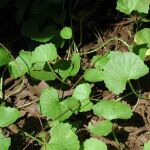| Medicinal Uses: |
Internally for wounds, chronic skin conditions (including leprosy), venereal disease, malaria, varicose veins and ulcers, thread veins, night cramps, nervous disorders, mental retardation, and senility. Excess causes headaches and transient unconsciousness, or may interfere with hypoglycemic therapy. It may also increase serum-cholesterol levels. Gotu kola is contraindicated in pregnancy and epilepsy. Externally for wounds (especially after surgery or burns), ulcers, eczema, hemorrhoids, and rheumatic joints.
To treat depression, rheumatism, skin diseases, poor circulation, scabies, and poorly healing wounds.
Gotu kola has antibacterial, anti-inflammatory, calming, digestive, diuretic, immune-stimulating, laxative, sedating, tonic, and wound-healing properties. The herb also appears to promote blood circulation in the legs. Extracts of the whole plant are used as a general restorative tonic that promotes long life, optimal health, and mental and physical relaxation. The leaves of the plant contain high concentrations of the herb's most active and potent chemical ingredient, asiaticoside, which is a powerful antibacterial and immune stimulant. Extracts of the leaves inhibit scarring and are used to treat cuts, psoriasis, skin grafts, burns and wounds. Gotu kola is taken internally most frequently for anxiety, edema, hyperactivity, insomnia, mental agitation, poor blood circulation in the legs, and stress. It is applied externally, in compresses for burns, psoriasis, and skin injuries. |
| Drug Interactions: |
| Taking gotu kola with these drugs may cause excessive sedation and mental depression and impairment: |
| Alprazolam, (Apo-Alpraz, Xanax) |
Aripiprazole, (Abilify) |
Baclofen, (Lioresal, Nu-Baclo) |
Bromazepam, (Apo-Bromazepam, Novo-Bromazepan) |
Buprenorphine, (Buprenex, Subutex) |
Buproprion, (Wellbutrin, Zyban) |
| Buspirone, (BuSpar, Nu-Buspirone) |
Butabarbital, (Butisol Sodium) |
Butorphanol, (Apo-Butorphanol, Stadol) |
Carbamazepine, (Carbatrol, Tegretol) |
Chloral Hydrate, (Aquachloral Supprettes, Somnote) |
Chlordiazepoxide, (Apo-Chlordiazepoxide, Librium) |
| Chlorpromazine, (Thorazine) |
Citalopram, (Celexa) |
Clobazam, (Alti-Clobazam, Frisium) |
Clonazepam, (Klonopin, Rivotril) |
Codeine, (Codeine Contin) |
Cyclobenzaprine, (Flexiril, Novo-Cycloprine) |
| Dantrolene, (Dantrium) |
Diazepam, (Apo-Diazepam, Valium) |
Diphenhydramine, (Benedryl Allergy, Nytol) |
Doxylamine and Pyroxidine, (Dilectin) |
Fentanyl, (Actiq, Duragesic) |
Fluoxetine, (Prozac, Sarafem) |
| Fluphenazine, (Modecate, Prolixin) |
Flurazepam, (Apo-Flurazepam, Dalmane) |
Gabapentin, (Neurontin, Nu-Gabapentin) |
Haloperidol, (Haldol, Novo-Peridol) |
Hydromorphone, (Dilaudid, PMS-Hydromorphone) |
Hydroxyzine, (Atarax, Vistaril) |
| Levorphanol, (Levo-Dromoran) |
Lorazepam, (Ativan, Nu-Loraz) |
Loxapine, (Loxitane, Nu-Loxapine) |
Meperidine, (Demerol, Meperitab) |
Meprobamate, (Miltown, Movo-Mepro) |
Mesoridazine, (Serentil) |
| Methadone, (Dolophine, Methadose) |
Methocarbamol, (Robaxin) |
Methotrimeprazine, (Novo-Meprazine, Nozain) |
Midazolam, (Apo-Midazolam, Versed) |
Mirtazapine, (Remeron) |
Molindone, (Moban) |
| Morphine Sulfate, (Kadian, MS Contin) |
Nalbuphine, (Nubain) |
Olanzapine, (Zydis, Zyprexa) |
Oxazepam, (Novoxapam, Serax) |
Oxcarbazepine, (Trileptal) |
Oxycodone, (OxyContin, Roxicodone) |
| Oxymorphone, (Numorphan) |
Paclitaxel, (Onxol, Taxol) |
Perphenazine, (Apo-Perphenazine, Trilafon) |
Phenobarbital, (Luminal Sodium, PMS-Phenobarbital) |
Phenytoin, (Dilantin, Phenytek) |
Pizotifen, (Sandomigran) |
| Prazepam, (Prazepam) |
Primidone, (Apo-Primidone, Mysoline) |
Prochlorperazine, (Compazine, Compro) |
Promethazine, (Phenergan) |
Quetiapine, (Seroquel) |
Risperidone, (Risperdal) |
| Ropinirole, (Requip) |
S-Citalopram, (Lexapro) |
Sertraline, (Apo-Sertraline, Zoloft) |
Sodium Oxybate, (Xyrem) |
Temazepam, (Novo-Temazepam, Restoril) |
Thiethylperazine, (Torecan) |
| Thioridazine, (Mellaril) |
Thiothixene, (Navane) |
Tiagabine, (Gabitril) |
Tizanidine, (Zanaflex) |
Tolcapone, (Tasmar) |
Tramadol, (Ultram) |
| Triazolam, (Apo-Triazo, Halcion) |
Trifluoperazine, (Novo-Trifluzine, Stelazine) |
Vigabatrin, (Sabril) |
Zaleplon, (Sonata, Starnoc) |
Zolpidem, (Ambien) |
Zopiclone, (Alti-Zopiclone, Gen-Zopiclone) |
| Zuclopenthixol, (Clopixol) |
| Taking gotu kola with these drugs may interfere with the action of the drug: |
| Acarbose, (Prandase, Precose) |
Acetohexamide, (Acetohexamide) |
Acipimox, (Acipimox, Olbetam) |
| Aspirin and Pravastatin, (Pravigard PAC) |
Atorvastatin, (Lipitor) |
Bezafibrate, (Bezalip, PMS-Bezafibrate) |
| Chlorpropamide, (Diabinese, Novo-Propamide) |
Cholestyramine, (Prevalite, Questran) |
Ciprofibrate, (Estaprol, Modalim) |
| Clofibrate, (Claripex, Novo-Fibrate) |
Colesevelam, (WelChol) |
Colestipol, (Colestid) |
| Fenofibrate, (Lofibra, TriCor) |
Fluvastatin, (Lescol) |
Gemfibrozil, (Apo-Gemfibrozil, Lopid) |
| Gliclazide, (Diamicron, Novo-Gliclazide) |
Glimepiride, (Amaryl) |
Glipizide, (Glucotrol) |
| Glipizide and Metformin, (Metaglip) |
Gliquidone, (Beglynor, Glurenorm) |
Glyburide, (DiaBeta, Micronase) |
| Glyburide and Metformin, (Glucovance) |
Insulin, (Humulin, Novolin R) |
Lovastatin, (Altocor, Mevacor) |
| Metformin, (Glucophage, Riomet) |
Miglitol, (Glyset) |
Nateglinide, (Starlix) |
| Niacin, (Niacor, Nicotinex) |
Niacin and Lovastatin, (Advicor) |
Pioglitazone, (Actos) |
| Pravastatin, (Novo-Pravastatin, Pravachol) |
Probucol, (Probucol) |
Repaglinide, (GlucoNorm, Prandin) |
| Rosiglitazone, (Avandia) |
Rosiglitazone and Metformin, (Avandamet) |
Rosuvastatin, (Crestor) |
| Simvastatin, (Apo-Simvastatin, Zocor) |
Tolazamide, (Tolinase) |
Tolbutamide, (Apo-Tolbutamide, Tol-Tab) |
|

